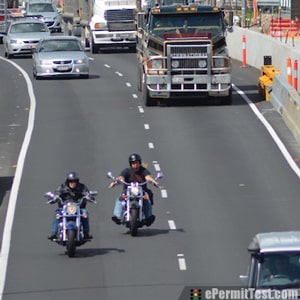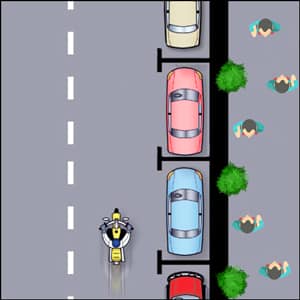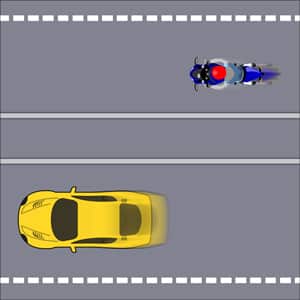Alabama Motorcycle License Practice Test 3
BEFORE CHANGING LANES TO THE LEFT:

Use your mirrors and turn your head to look for traffic behind. Turning your head will allow you to check for vehicles that may be in your blind spot otherwise.
TO PREDICT HOW A HAZARD MAY AFFECT YOU, IT'S IMPORTANT TO:
IN THIS PICTURE, YOU ARE PASSING PARKED CARS. THE GREATEST DANGER TO YOU IS:

A car pulling away from the curb or making a U-turn are the most dangerous. They can cut you off entirely, blocking the whole roadway and leaving you with no place to go.
ON A PAVED TWO-LANE ROAD, SAND AND GRAVEL ARE MOST LIKELY TO COLLECT:
Dirt and gravel collect along the sides of the road — especially on curves and ramps leading to and from highways. Be aware of what’s on the edge of the road, particularly when making sharp turns and getting on or off freeways at high speeds.
IF YOU MUST STOP QUICKLY WHILE TURNING AND YOU ARE UNABLE TO STRAIGHTEN THE MOTORCYCLE FIRST, APPLY THE:
TO CREATE MORE SPACE AND MINIMIZE HARM FROM ANY HAZARD:
A GROUP OF RIDERS MOVE FROM A STAGGERED FORMATION INTO A SINGLE FILE WHEN:
Move into a single-file formation when riding curves, turning, and entering or leaving a highway.
Advertisement
WHEN FOLLOWING A VEHICLE, YOU SHOULD TRY TO:
If you ride in the left or right portion of the lane, the driver may (or may not) see you in his or her side view mirror. The center lane position is usually the best place for you to be seen by the driver in his or her rearview mirror and to prevent other vehicles from sharing your lane.
WHEN YOU RIDE AT NIGHT:
Wearing reflective clothing at night gives you a better chance of being seen by other drivers.
ALCOHOL FIRST AFFECTS YOUR:
Alcohol and other drugs, more than any other factor, affect your ability to think clearly and to ride safely. As little as one alcoholic drink can have a significant effect on your performance.
IF YOUR THROTTLE STICKS:
If the throttle stays stuck immediately operate the engine cut-off switch and pull in the clutch at the same time. This will remove power from the rear wheel, though engine noise may not immediately decline. Once the motorcycle is “under control,” pull off and stop.
WITH A PROPERLY ADJUSTED MIRROR, YOU CAN SEE:
Clean and adjust both mirrors before starting. Adjust each mirror so you can see the lane behind and as much as possible of the lane next to you. When properly adjusted, a mirror may show the edge of your arm or shoulder — but it’s the road behind and to the side that’s most important.
WHEN YOU TURN:
When you turn, look through the turn to where you want to go. Turn only your head, not your shoulders, and keep your eyes level with the horizon.
MOST MOTORCYCLE/CAR CRASHES:
Over one-half of motorcycle/car crashes are caused by drivers entering a rider’s right-of-way. Cars that turn left in front of you, including cars turning left from the lane to your right, and cars on side streets that pull into your lane, are the biggest dangers.
Advertisement
TO AVOID CAUSING A REAR-END COLLISION WHEN FOLLOWING ANOTHER VEHICLE:
In traffic, motorcycles need as much distance to stop as cars. Normally, a minimum of two seconds distance should be maintained behind the vehicle ahead.
IF YOU HAVE A FLAT TIRE WHILE RIDING, HOLD THE HANDLE GRIPS FIRMLY AND:
If a tire goes flat while riding, holding handgrips firmly, ease off the throttle and keep a straight course. Avoid braking. If braking is necessary, gradually apply the brake off the tire that isn't flat.
TO CROSS TRACKS THAT RUN PARALLEL TO YOUR COURSE:

For tracks and road seams that run parallel to your course, move far enough away from tracks, ruts, or pavement seams to cross at an angle of at least 45°. Then, make a deliberate turn.
TO MAKE A NORMAL STOP, USE:
When making a normal, non-emergency stop, use both brakes at the same time and downshift. Using both brakes for normal stops helps you develop the proper habit and skill of using both brakes correctly, which you may need in an emergency.
IN THE PICTURE, THE CAR IS WAITING TO ENTER THE INTERSECTION. USUALLY, IT IS BEST FOR YOU TO:

WEARING A DOT-CERTIFIED HELMET WILL:
Head injuries account for the majority of serious and fatal motorcyclist injuries and, with few exceptions, head injuries are reduced by properly wearing a motorcycle safety helmet.